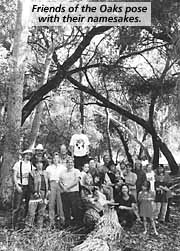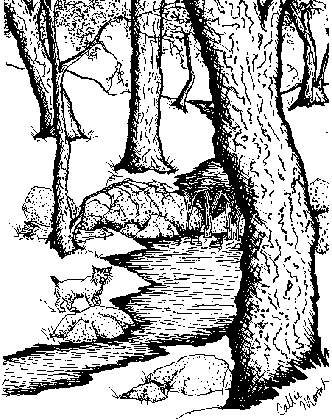by Wanda Kwiatt
![]() raveling down the twisted, narrow Mussey Grade Road
in Ramona, one is embraced by its natural woodland canopy. San Diego residents
may remember it as part of the Old Julian Highway, before the San Vicente
Reservoir was built. Flooding the small town of Foster established the dead-end
road now named Mussey Grade Road.
raveling down the twisted, narrow Mussey Grade Road
in Ramona, one is embraced by its natural woodland canopy. San Diego residents
may remember it as part of the Old Julian Highway, before the San Vicente
Reservoir was built. Flooding the small town of Foster established the dead-end
road now named Mussey Grade Road.
Time has stood still in this pristine little
valley since stagecoach travelers first beheld it. The seasonal west branch
of the San Vicente Creek meanders adjacent to the road, occasionally crossing
under it. Bobcats and large wildlife travel along the creek. Giant oak trees
are home to a variety of birds. One neighbor's letter to save these oaks
called them "treasures and landmarks of Mussey Grade." Over one
hundred years of travelers under this woodland canopy would agree.
Four years ago, my family moved to an old ranch
next to the oak woodland. I'll never forget the first time I heard the falling
crack of an aged oak echoing through the woods. Drought and wind followed
by rain naturally felled the old tree, leaving a massive hole in the woodland
canopy. I mourned its loss until the sun shone through the hole, revealing
several young trees that had been struggling for light. I'm sure it will
be a hundred years or so before the canopy is replaced by one of these younger
trees. Of course, people unfamiliar with this area wouldn't notice the canopy
lacking one tree. But if one tree's loss impacts these woods so greatly,
I feel half an acre 9 to 13 mature trees must be significant to the woodland
as a whole.

At a Ramona Community Planning meeting,
I was shown plans to improve an additional 5 - 10 foot pathway along the
west side of Mussey Grade Road for non-motorized uses. A quick count revealed
about 81 mature oak trees in the proposed pathway project. A petition was
circulated, and 10 residents attended the next planning meeting with 45
signatures and 15 letters. One letter from a young resident summed it up:
"Those oak trees have been standing there for hundreds of years. It
would be a shame to take them out now. Trails are nice, but not at the expense
of the oaks."
During the last two years, I've written letters,
spoken at county public meetings and encouraged neighbors to participate.
This neighborhood was successful in removing the pathway project though
the middle of this oak woodland. But that is just one threat to the woodland.
A project at the top of the valley was stopped
for illegally grading a massive road near our resident eagle's nest that
sent eroded soils into the creek. A small plan for four lots was cited for
building an unpermitted earth culvert across the creek. A proposed 12-lot
subdivision along the outside fringe of the oaks woodland recently reduced
its plan to 5 lots, removing leach field within the woodland.
A proposed 13-lot subdivision plans to impact
.49 acres of oak woodland. While this is a true improvement over their original
plan of impacting 3 acres, it still includes a new road impacting 9 to 13
mature trees. These projects may mitigate by planting 10 one-gallon oak
tress for the loss of each mature oak tree. But would the critters stay?
If everyone got what they wanted, there would
be nothing left. Projects want "Negative Declarations" from the
county, stating they have no significant impacts. Grading violators only
pay a $500 fine, added to their permit costs. In June of 1996, I publicly
requested that the Board of Supervisors provide stronger grading enforcement.
The County Chief Administrator reported back with 426 backlogged uncollected
cases and planned to send new notification reminders.
I do believe that each one of these projects
planned to take advantage of this scenic woodland, too. However, I wonder
after everyone is finished impacting the oaks only a little each time, carefully
planting 10 one-gallon oak for the loss of each mature tree will the result
resemble a woodland or an oak landscape? Will there be pristine areas left
for multiple-habitat planning efforts like the MSCP to preserve?
I've checked into the Regional Growth Management
Strategy and there's no enforcement. We're busy protecting the same trees
over and over again. It's insanity. We're worn thin.
But people do make the difference. Chi Vanardo
and her two daughters, third-generation Mussey Grade residents, wrote letters
and asked neighbors to help save the oaks. On a larger scale, Iron Mountain
Conservancy continually educates all who want to learn about the precious
resources found in Ramona. Tim Moore, president of IMC, was the first person
I called when oaks started to fall on Mussey Grade. That led me to attend
the IMC Winter Raptor Watches led by Fred Sproul, to witness eagles foraging
in the Ramona Airport native grasslands, a wildlife corridor for migrating
birds. Ramona resident Dave Bittner of the Eagle Survey Project [see SDET
2/97], has collected data showing that preserving eagle foraging areas is
as important as protecting their nests.
At a planning group meeting, I saw plans to
develop 740 houses in the native grasslands around the airport. The community
plan called for a maximum of 166 houses. Does it make sense to locate structures
next to an airport? Haven't we learned from the problems of people whose
houses are next to airports? Aren't areas next to airports better left to
open-space uses? The resident golden eagles and burrowing owls can still
survive there. Doesn't diminishing native grasslands containing San Diego's
largest vernal pools matter? Open-space uses would solve the public services
and infrastructure dilemma.
This planned infringement called myself and
other Ramona residents to arms. It started with knocking on doors, and Ramonan
hospitality allowed us to quickly form the Neighborhood Coalition. Meeting
in homes, we explained the planning process: the importance of public comment
on projects, letter writing, and participation in public meetings to identify
key quality-of-life issues for our community.

This drawing was done especially for SDET by Callie Moriah, age 17, to express her view of the woods she loves.
Kristi Mansolf, a founder
of Ramonans for Sensible Growth, endlessly rallied residents to be become
involved in the planning and future of their community. The mission of RSG
is to preserve and enhance the rural character of the Ramona community and
encourage land uses which are compatible with a rural lifestyle.
Kristi was motivated by her numerous hikes
up Mt. Woodson, with its birds-eye view of Ramona's remaining grasslands
and the entire pastoral canvas. The latest Airport Extension Project proposes
commercial and industrial development right in the center of this grassland.
It will take more dedicated people to balance environment and growth. Because
that's what people want - balance. We aren't anti-growth, but we want sensible
development that respects the community and the environment.
Growth that respects our environment has turned
into an active family affair. Our five children help with phone messages
and enter information into our computer. My husband's "honey-do list"
now includes earth errands. Our eldest daughter drew the bird on the first
edition of the Iron Mountain Conservancy's Santa Maria Valley bird checklist.
We experienced a very special moment when she chose to miss a few hours
of school to speak before the Planning Commission on the Resource Protection
Ordinance. My 9-year-old son states with a smile, "I started this [making
a difference] when I did my third grade report on golden eagles, huh Mom?"
His concerns encourage me, especially when I come home from meetings and
he asks, "How many trees did you save today, Mom?" "I'm not
sure," I answer. "I think all I do is try to save the same trees
every week."
![]()
IMC has set up an Eagle Fund to preserve eagle
habitat. As part of IMC educational lecture series, Ramona Our Heritage
Our Home, Richard Carrico will present "Prehistoric Peoples of the
Valley of the Sun, Ramona's First Inhabitants" on April 25, 7pm at
the Ramona Elementary (junction of 8th and F). IMC: (760) 788-WILD; Ramonans
for Sensible Growth: (760) 789-7502; Neighborhood Coalition (760) 788-6788.